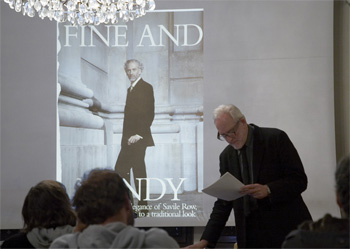Roger Cook Site Talk Transcript
I Was a 1980s Commodity Fetish: thoughts provoked by Christian Capurro's "Another Misspent Portrait of Etienne de Silhouette"
This is a transcript of the talk Roger Cook gave on the 20th of November 2007 at the Fondazione Bevilacqua La Masa, Palazzetto Tito, Venice. The talk was one of six 'off-site' presentations with invited collaborators that formed part of Christian Capurro's 'Another Misspent Portrait of Etienne de Silhouette' project in 'Think with the Senses-Feel with the Mind. Art in the Present Tense' at the 52. International Art Exhibition - Venice Biennale.
....
A collaborative project in which over a five year period 260 persons, ranging in age between eight and eighty were asked to completely and anonymously erase one page of a 246 page September 1986 Vogue Hommes. The artist tells us that:
Additionally, they were asked to write in pencil on the page both the time it took them to erase the page - ranging from 9 minutes to just beyond 3.5 hours - and whatever monetary value, translated into an hourly rate/s, they currently received for their time. Consequently, each page has a nominal value based on the sum of these indices. The dollar value accrued 'on' each page ranges from nothing in a number of instances (some contributors were receiving no calculable money for their time) to one page 'worth' over USD$1,000. Such disparities are central to the work. Taken together the accumulated monetary value of all these peoples' pages proposes a value, of sorts, for the work as a whole.
As with many resonant artworks, the experience of Christian Capurro's Another Misspent Portrait of Etienne de Silhouette ultimately exceeds anything that might be said about it. Tom Nicholson, in the first of these off-site talks described its "persistence [as] a function [of the] paradox [of its] muteness". However that muteness engenders discursive response. Something the artist himself acknowledges by engaging off-site talks in relation to the work. I am the latest in a sequence of such responses.
I was immediately affected when I encountered Another Misspent Portrait of Etienne de Silhouette in the Arsenale for the first time some months ago. I was arrested by the strangeness of its title and affected by the boldness and simplicity of the idea, the beauty and fragile physicality of the work itself. The result of the labour of many hands over a considerable period of time, a work concerned at its core with the quantative and qualitative nature of labour.
I was simultaneously affected by this work by virtue of its subjective resonance with events in my own life, as well as its objective aesthetic resonance with the historical trajectory of modern and contemporary art and culture.
I will speak of the former first: the resonance with events in my own life in the 1980s, the period when by chance I became a 'commodity fetish' and appeared as a fashion model in the pages of Vogue Homme and L'Uomo Vogue. The erased Vogue Hommes magazine at the heart of Christian Capurro's project was published in 1986.
Many would agree with the contemporary French philosopher Alain Badiou, who at the start of his book of reflections entitled The Century calls the "last twenty years of the [twentieth] century [...] the second Restoration". The first being that following the French Revolution of 1792-4. He declares these last decades a period of conservative restoration, of the acceleration of global capitalism, commodification and the domination of the 'get rich' ethos of Reaganism and Thatcherism, from which we are still struggling to be free. As he says in another text our capitalist world is "coded, oriented or channeled by the infinite glitter of merchandise".1
In the middle of the 1980s, I was fortuitously accosted in a street market in London by a fashion scout for the Japanese fashion designer Yohji Yamamoto who asked me if I would be interested in doing some work for a couple of days over a weekend in Paris. I did not really understand what he was talking about but let him take a couple of polaroids and thought nothing more of it. I was surprised when I was later contacted and asked if I would be interested in doing this work, which turned out to be cat walk modeling for Yamamoto's menswear show. At this time I had little knowledge of the fashion world, having worked for over twenty years as an artist and as an academic in a fine art department in an English university. There is a further personal twist to this story insofar as aged 45 I had just recovered from convalescing after an operation as a result of osteoarthritis in my right hip. Having been on crutches for several months, I had only recently ceased walking with a stick. As you can imagine it was rather surprising to be suddenly gliding down the catwalk in the show of a famous Japanese fashion designer. After the show which was before a large audience with many press photographers I was approached by a modeling agency in London to see if I would like to earn some extra money as a part-time fashion model. The glamour of this offer and the possibility of earning extra money were irresistible, so I joined the agency. As a result I managed to earn substantial amounts of money over the next five or so years, money that I could never have dreamt of earning in my capacity as an artist and academic.
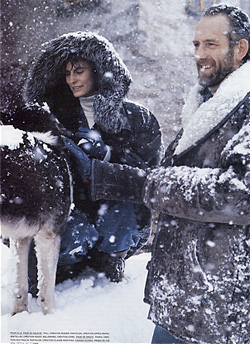
Roger Cook in Vogue Hommes, 1987
Though I would like to stress that it was primarily the purely aesthetic qualities (which paradoxically are not 'purely aesthetic') of Christian's work that initially drew me to it, you can perhaps now begin to understand why it so attracted my attention, for like him, as a result of my work in the fashion industry I had been confronted with certain troubling questions concerning the exchange value of labour relative to the world of commerce and that of art. I knew what it was to be a commodity fetish, an object to be looked at, for economic exchange in the high fashion field of commodity capitalism, and I further knew that this field was absurdly at odds with the ideals of art and culture that I was committed to in my professional life.
This happenstance forced me to think about the nature of exchange, in the same way that Christian was compelled to think it when he realized that the value of his time as a professional photographer photographing works was "much, much higher, remuneration-wise, than it was (or might ever be!) as an artist". Furthermore I was caught in an ethically troubling situation engaged in an activity completely at odds with my professional, cultural and intellectual commitments. The response of my colleagues was mixed. Some celebrated this chance occurrence as a harmless piece of fun and good fortune, others resented it bitterly, regarding my willing cooption into the fashion industry as betrayal: an indication of moral weakness and the narcissism they automatically associated with homosexuality. Meanwhile, I was having a wonderful time traveling all over the world working with some of the most talented designers and photographers in the industry. Furthermore this glamorous life increased my social capital considerably, especially with my students who were, suitably or unsuitably as the case maybe, impressed. In the meantime my cultural life continued to develop and I acquired a more refined taste not only sartorially, but also intellectually, for besides clothing, I also amassed a library of theoretical texts on aesthetics, philosophy and the sociology of art.
Then, in 1992, more or less at the end of my modeling 'career' I discovered the work of the French sociologist, Pierre Bourdieu, a discovery that was to change my life. Bourdieu, had a theory of capital which helped explain a lot about what he called the "field of cultural production". He differentiates different forms of capital; not just economic capital, but forms of social capital such as culture and education. He demonstrates how these forms of capital are both inherited, acquired, and, most importantly, exchanged. This enabled me to gain a degree of social objectivity on my absurdly anomalous existence. My perceived aristocratic physiognomy had been a fortuitous form of inherited social capital which had become an acquired form of social capital which had been exchanged for economic capital, but which, in turn, endangered the standing of my cultural capital. Unconsciously, no doubt in compensation, this encouraged me to work harder to increase my intellectual capital and I embarked on more and more serious research into the theoretical aspects of my chosen field: contemporary art and culture, finally embarking on PhD research into contemporary performance art. In the meantime, my standing amongst students had been further enhanced by the invitation of my old acquaintance, 'queer' film maker Derek Jarman, to 'star' as a featured extra (Jesus Christ) in his film The Garden, a film he made in response to the AIDS pandemic and his courageously announced HIV status.
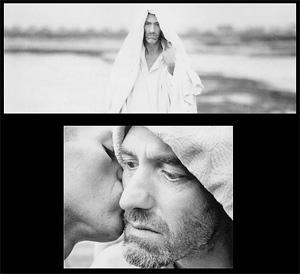
Roger Cook as Jesus in Derek Jarman's The Garden
Which brings us back to the question of the exchange value of work in the culture industry as against the value of work in the commercial world. At this point I should tell you that for the privilege of appearing in his film, I received the princely sum of fifty pounds, whilst at the height of my modeling career my 'day rate' was over one thousand pounds!
We all have to work, and we know to our cost that the qualitative experience of this work differs in degree, reward and remuneration. Their relation is a complex one. Those who choose to engage in artistic activity are, generally, especially early on, poorly rewarded, as though society wished to punish them for their devotion to art.
For Alain Badiou, the contemporary French philosopher to whom I referred earlier, art is one of the four modes of commitment to that conjunction of being and event that he calls the 'the event of truth'. Events of truth take place in four general fields of truth, or domains of subjectivation (which in turn operate as the four generic 'conditions' of philosophy itself): art, love, science and politics; creation, passion, invention and revolution. There are artistic, amorous, scientific and political truths. It takes courage and what he calls sustained fidelity to the event to be a scientist, a revolutionary, a lover and an artist.
To want to be an artist is a calling rather than a career. The same applies no doubt to the revolutionary, the lover and the scientist, none enter these domains to advance a career: they are callings. But what exactly is a 'calling'? Badiou, would I think call it a fortuitous confrontation between 'being and event'- the title of his magnum opus: L'être et l'événment (1988). It is the confrontation with the fortuitous experiential event of art itself which calls forth the artist, just as it is the fortuitous experiential political event that calls forth the revolutionary, the fortuitous event of love that engages the devotion of the lover, and the experimental event that calls forth the scientist: the apple falling from the tree for Newton, the bacillus floating through the window for Fleming. Art engenders creation; passion love; revolution politics; experimentation science. These four: creation, passion, invention and revolution; art, love, science and politics, are, of course not unrelated. The creation of a successful art work, such as Another Misspent Portrait of Etienne de Silhouette demands in its making a certain operational functionality akin to that of science; passionate devotion akin to that of love; as well as a degree of political potentiality to transform the world.
Of the art historical resonances in relation to this work, Ross Moore in his off-site talk in Australia drew attention to the works relation to Rauchenberg's famous 1953 erasure project the Erased De Kooning Drawing. Rauschenberg was part of that nexus of artists in the ambit of John Cage who equally famously asserted the musical value of silence. Magazine culture is a part of the visual noise that pervades global advertising. Christian's project assumes the value of the visual silence that underlies visual culture and joins the company of twentieth century artists like Kasimir Malevich, Agnes Martin, Robert Ryman and other 'minimalists' who assert the value of the surrounding silence that enfolds all aural and visual culture.
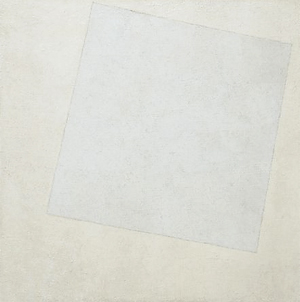
Kasimir Malevich, White on White, 1918
I now want to shift gear slightly and very briefly try to relate Christian's erasure project to Alain Badiou's ideas concerning Destruction, Negation and Subtraction.2 Badiou writes of the twentieth century 'passion for the real' manifest politically, artistically and philosophically in the idea of a clean break, in a necessary destruction. However Badiou sees another version of this 'passion for the real' manifest as subtraction; a differentiating passion that opposes the construction of minimal difference exemplified in painting by Malevich's White on White.
In the simplest terms the erasure of this copy of Vogue Hommes is not a destruction. It is easy to see however that it is a negation, a negation of the original object, and this negation is performed by means of a subtraction: the painstaking removal of the layers of printed matter that made up the images of this magazine. This 'event' has transformed the original magazine, an ephemeral negatively commercial commodity fetish, into a negative palimpsest, which takes on a new positively fetishized function as an artistic production.3
Now for some words concerning the relation of all this to dandyism, whose flowering in the middle of the eighteenth century marked a radically new sense of the construction of the self. It was around this time that a radical social transformation took place which is the historic birth of what we call public culture. It was at this time also that the capitalist culture of consumption and the 'society of the spectacle' was born. A nodal point for this flowering of dandyism is the relationship between the British commoner 'Beau' Brummell and the future King George IV when he was Prince of Wales. The title of my research project is "democratic dandyism" and it asserts the 'singular plural' right of anybody and everybody to pursue distinction.4 Dandyism, as Charles Baudelaire pointed out is often wrongfully associated with sartorial splendour, whereas the reverse is in fact true.5 Beau Brummell's dandyism challenged the foppish extravagance of the aristocracy which Brummell considered vulgar and ostentatious. Brummell, in fact, was a 'minimalist' who (like Christian Capurro) sought distinction in subtraction: the removal of all superfluous decoration from aristocratic attire.
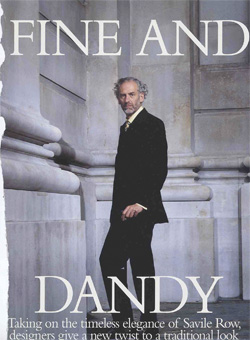
Roger Cook, Fine and Dandy
This notion of dandyism has a specific relation to the history of art and Christian's erasure project. In 1988, not long after the erased copy of Vogue Hommes was published, the American art historian Carter Ratcliff, published a highly regarded article: "Dandyism and Abstraction in a Universe Defined by Newton" in the December Artforum. In this fascinating article Ratcliff outlined some of the essential qualities of dandyism in relation to modern art; citing the 18C essayist William Hazlitt (who knew Brummell) he evoked the nonchalance, detachment and vacancy of the dandy's wit, and wrote of the dandy's refusal to be moved, an immobility of movement which Carter saw represented in modernist painting particularly in the vacant, non-descriptive passages of brushwork in some paintings of Edouard Manet; the non-descriptive purely painterly passages in early Cubist works of Picasso and Braque; the non-objective immobility and stasis - blankness of form - in the paintings of Piet Mondriaan, Kasimir Malevich and Robert Ryman, and other 'dandified abstractionists'. Finally, he mentions the quintessential 19C dandy poet Stéphane Mallarmé (great imagist of the event) who wrote of the "empty page" being "defended by its whiteness"- to be seen in the way he scattered words across the emptiness of its surface in his famous poem Un Coup de Des Jamais n'Abolira le Hasard (A Cast of the Dice Never Will Abolish Chance). In 1969 Marcel Broodthaers produced his own version of this poem entitled Un coup de dés jamais n'abolira le hazard. Image in which he blocked out Mallarmé's text in proportion to the size and scale of the printed words and placed in the same relationship on the page, the rectangular units exactly matching Mallarmé's linear sequence of words and phrases, further emphasizing the empty space of the paper.6

Marcel Broodthaers, Un coup de dés jamais n'abolira le hazard. Image (Transparent version), 1969
Here the ultimate whiteness of the paper, might reminds us of Mallarmé's exemplar, Baudelaire's statement in My Heart Laid Bare regarding egoism and the importance of its 'vaporisation' for the aesthetic detachment of dandyism: "De la vaporisation et de la centralisation du Moi. Tout est là" (Of the vaporization and centralization of the Ego. All depends on that).7 The ultimate goal of this vaporisation lies in a quietening of the self in favour of infinity and silence, a Stoic calm and resigned acceptance of the temporality and ephemerality of life.
For Badiou, Malevich's White on White of 1918 is - within the field of painting - the epitome of just such a vaporization or purification, the "support of a minimal difference of ground and form [...] the null difference between white and white, the difference of the same". "We must beware," he warns us "of interpreting White on White as a symbol of the destruction of painting" for what we are dealing with is "a subtractive assumption". And he continues to say that this gesture is close to that of Mallarmé:
the staging of a minimal, albeit, absolute, difference; the difference between the place and what takes place in the place, the difference between place and taking-place. Captured in whiteness, this difference is constituted through the erasure of every content, every upsurge.8
Badiou goes on to quote a fragment of a poem that Malevich wrote just before he painted White on White in 1918. I hope you will agree that it has extraordinary resonance both with the absurdity of my fortuitous brush with commodity fetishism, and most especially with Christian's project.
Erase, be quiet, stifle the fire if fire it be,
so that the corset of your thoughts may be lighter
and not rust.
So that you may hear the breath of a new day in the desert.
Cleanse your hearing, erase the bygone days, only thus
will you be more sensitive and more white,
for like a dark stain these days sagely
lie upon your vestments, and in the breath of the wave
you will find the furrow of the new.
Your thought will find the contours and stamp them with the seal
of your advance.
It might have been apposite to end at this point, but this is not possible, for, there is more than silent erasure to deal with here: there is the rustle of reinscription. Christian asked his erasers to inscribe in pencil on their pages, the time the work took, and to calculate on the basis of their normal hourly rate, the amount they should ordinarily have been paid. As the artist tells us: "The value accrued 'on' each page ranges from nothing in a number of instances [...] to one page 'worth' over USD$1,000", and, he adds: "These disparities matter to the work". On the poster he puts the total number of hours, and the equivalent amount in dollars that might have been earned for this collaborative work. In The Century Alain Badiou suggests that conservative restoration is always obsessed with numerical quantification, the exact equivalence of time and money in "dollars or euros". So Another Misspent Portrait of Etienne de Silhouette importantly opens up the question of value and labour and its relation to being and event. For Alain Badiou, the radically new, of possibility and innovation (and hence, revolution) - of "events" of truths rupture or break from the given situation (things as they simply are). Badiou argues that truth "punches a hole" in the situation, and that this truth-event which breaks from the situation induces a new subject, who is a bearer of a truth. Through this new artistic configuration Christian Capurro and his collaborators in Another Misspent Portrait of Etienne de Silhouette induce us - new subjects - to follow, in Malevich's words - the 'furrow of the new'.9
....
Roger Cook speaking at the Fondazione Bevilacqua La Masa, Palazzetto Tito, Venice 20.11.07
....
1Alain Badiou, The Century, p.26. "The Desire for Philosophy and the Contemporary World". http://www.lacan.com/badesire.html
2Elaborated in Alain Badiou, "Subtraction, Negation, Destruction: On Pier Paolo Pasolini" 2007. http://www.lacan.com/badpas.htm
3This magazine, like all magazines produced by media culture, as Badiou writes:
Western democracy [...] is marketing and communication.[...] true art is that which interrupts marketing, that which communicates nothing. Immobile and incommunicable, this is the art we need, the only one that addresses everyone, not circulating according to any pre-established network and not communicating with anyone in particular.
4Jean-Luc Nancy, Being Singular Plural, Stanford 2000
5Charles Baudelaire, The Painter of Modern Life and Other Essays, London 1964, p.27
6There is valuable discussion of this work by Benjamin H.D. Buchloh, Anne Rorimer and Birgit Pelzer in Benjamin H.D. Buchloh, ed., Broodthaers: Writings, Interviews, Photographs, October 42, MIT Press, 1987
7Charles Baudelaire, "My Heart Laid Bare", Intimate Journals, New York: Dover Publications, 2008, translation by Christopher Isherwood, p.63
8Alain Badiou, The Century, p.56
9"A truth then expands out of this "evental site" [site événementiel] in so far as it elicits the militant conviction of certain individuals who develop the revolutionary implications of the event, and by doing so constitute themselves as the subjects of its truth." Peter Hallward, introduction to "Alain Badiou & Peter Hallward/Bruno Bostells, Beyond Formalisation: An Interview" Angelaki, Volume 8, Number 2 2003, p.112.
"What are we to understand [...] by an "artistic configuration"? A configuration is not an art form, a genre, or an "objective" period the history of art, nor is it a "technical" dispositif. Rather, it is an identifiable sequence, initiated by an event, comprising a virtually infinite complex of works, when speaking of which it makes sense to say that it produces-in a rigorous immanence to the art in question-a truth of this art, an art-truth." Alain Badiou, Handbook of Inaesthetics, Stanford University Press, 2004, p.13.
....

